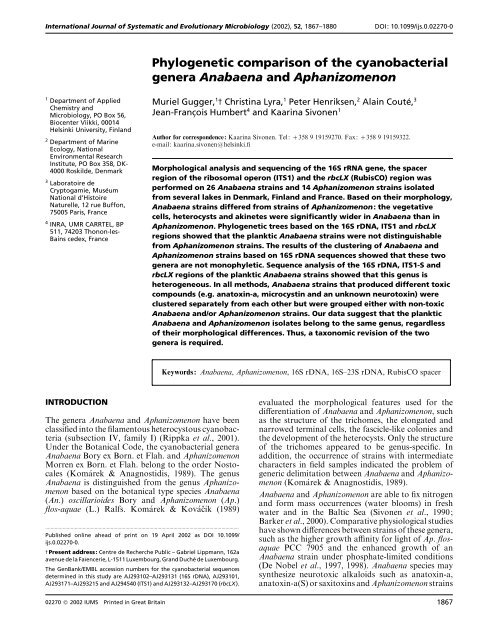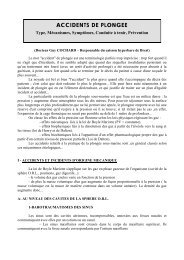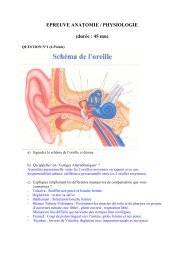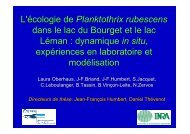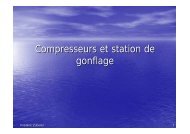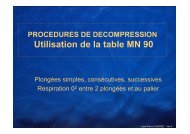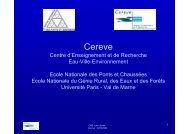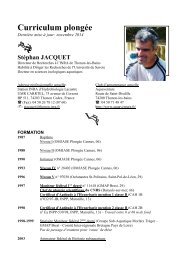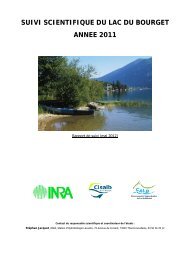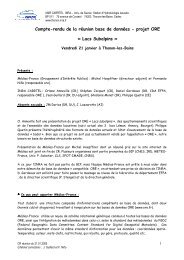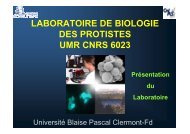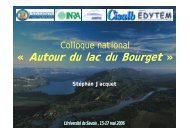Phylogenetic comparison of the cyanobacterial genera Anabaena ...
Phylogenetic comparison of the cyanobacterial genera Anabaena ...
Phylogenetic comparison of the cyanobacterial genera Anabaena ...
You also want an ePaper? Increase the reach of your titles
YUMPU automatically turns print PDFs into web optimized ePapers that Google loves.
International Journal <strong>of</strong> Systematic and Evolutionary Microbiology (2002), 52, 1867–1880DOI: 10.1099/ijs.0.02270-0<strong>Phylogenetic</strong> <strong>comparison</strong> <strong>of</strong> <strong>the</strong> <strong>cyanobacterial</strong><strong>genera</strong> <strong>Anabaena</strong> and Aphanizomenon1 Department <strong>of</strong> AppliedChemistry andMicrobiology, PO Box 56,Biocenter Viikki, 00014Helsinki University, Finland2 Department <strong>of</strong> MarineEcology, NationalEnvironmental ResearchInstitute, PO Box 358, DK-4000 Roskilde, Denmark3 Laboratoire deCryptogamie, Muse umNational d’HistoireNaturelle, 12 rue Buffon,75005 Paris, France4 INRA, UMR CARRTEL, BP511, 74203 Thonon-les-Bains cedex, FranceMuriel Gugger, 1 † Christina Lyra, 1 Peter Henriksen, 2 Alain Coute , 3Jean-Franc ois Humbert 4 and Kaarina Sivonen 1Author for correspondence: Kaarina Sivonen. Tel: 358 9 19159270. Fax: 358 9 19159322.e-mail: kaarina.sivonenhelsinki.fiMorphological analysis and sequencing <strong>of</strong> <strong>the</strong> 16S rRNA gene, <strong>the</strong> spacerregion <strong>of</strong> <strong>the</strong> ribosomal operon (ITS1) and <strong>the</strong> rbcLX (RubisCO) region wasperformed on 26 <strong>Anabaena</strong> strains and 14 Aphanizomenon strains isolatedfrom several lakes in Denmark, Finland and France. Based on <strong>the</strong>ir morphology,<strong>Anabaena</strong> strains differed from strains <strong>of</strong> Aphanizomenon: <strong>the</strong> vegetativecells, heterocysts and akinetes were significantly wider in <strong>Anabaena</strong> than inAphanizomenon. <strong>Phylogenetic</strong> trees based on <strong>the</strong> 16S rDNA, ITS1 and rbcLXregions showed that <strong>the</strong> planktic <strong>Anabaena</strong> strains were not distinguishablefrom Aphanizomenon strains. The results <strong>of</strong> <strong>the</strong> clustering <strong>of</strong> <strong>Anabaena</strong> andAphanizomenon strains based on 16S rDNA sequences showed that <strong>the</strong>se two<strong>genera</strong> are not monophyletic. Sequence analysis <strong>of</strong> <strong>the</strong> 16S rDNA, ITS1-S andrbcLX regions <strong>of</strong> <strong>the</strong> planktic <strong>Anabaena</strong> strains showed that this genus isheterogeneous. In all methods, <strong>Anabaena</strong> strains that produced different toxiccompounds (e.g. anatoxin-a, microcystin and an unknown neurotoxin) wereclustered separately from each o<strong>the</strong>r but were grouped ei<strong>the</strong>r with non-toxic<strong>Anabaena</strong> and/or Aphanizomenon strains. Our data suggest that <strong>the</strong> planktic<strong>Anabaena</strong> and Aphanizomenon isolates belong to <strong>the</strong> same genus, regardless<strong>of</strong> <strong>the</strong>ir morphological differences. Thus, a taxonomic revision <strong>of</strong> <strong>the</strong> two<strong>genera</strong> is required.Keywords: <strong>Anabaena</strong>, Aphanizomenon, 16S rDNA, 16S–23S rDNA, RubisCO spacerINTRODUCTIONThe <strong>genera</strong> <strong>Anabaena</strong> and Aphanizomenon have beenclassified into <strong>the</strong> filamentous heterocystous cyanobacteria(subsection IV, family I) (Rippka et al., 2001).Under <strong>the</strong> Botanical Code, <strong>the</strong> <strong>cyanobacterial</strong> <strong>genera</strong><strong>Anabaena</strong> Bory ex Born. et Flah. and AphanizomenonMorren ex Born. et Flah. belong to <strong>the</strong> order Nostocales(Koma rek & Anagnostidis, 1989). The genus<strong>Anabaena</strong> is distinguished from <strong>the</strong> genus Aphanizomenonbased on <strong>the</strong> botanical type species <strong>Anabaena</strong>(An.) oscillarioides Bory and Aphanizomenon (Ap.)flos-aquae (L.) Ralfs. Koma rek & Kova c ik (1989).................................................................................................................................................Published online ahead <strong>of</strong> print on 19 April 2002 as DOI 10.1099/ijs.0.02270-0.† Present address: Centre de Recherche Public – Gabriel Lippmann, 162aavenue de la Faı encerie, L-1511 Luxembourg, Grand Duche de Luxembourg.The GenBank/EMBL accession numbers for <strong>the</strong> <strong>cyanobacterial</strong> sequencesdetermined in this study are AJ293102–AJ293131 (16S rDNA), AJ293101,AJ293171–AJ293215 and AJ294540 (ITS1) and AJ293132–AJ293170 (rbcLX).evaluated <strong>the</strong> morphological features used for <strong>the</strong>differentiation <strong>of</strong> <strong>Anabaena</strong> and Aphanizomenon, suchas <strong>the</strong> structure <strong>of</strong> <strong>the</strong> trichomes, <strong>the</strong> elongated andnarrowed terminal cells, <strong>the</strong> fascicle-like colonies and<strong>the</strong> development <strong>of</strong> <strong>the</strong> heterocysts. Only <strong>the</strong> structure<strong>of</strong> <strong>the</strong> trichomes appeared to be genus-specific. Inaddition, <strong>the</strong> occurrence <strong>of</strong> strains with intermediatecharacters in field samples indicated <strong>the</strong> problem <strong>of</strong>generic delimitation between <strong>Anabaena</strong> and Aphanizomenon(Koma rek & Anagnostidis, 1989).<strong>Anabaena</strong> and Aphanizomenon are able to fix nitrogenand form mass occurrences (water blooms) in freshwater and in <strong>the</strong> Baltic Sea (Sivonen et al., 1990;Barker et al., 2000). Comparative physiological studieshave shown differences between strains <strong>of</strong> <strong>the</strong>se <strong>genera</strong>,such as <strong>the</strong> higher growth affinity for light <strong>of</strong> Ap. flosaquaePCC 7905 and <strong>the</strong> enhanced growth <strong>of</strong> an<strong>Anabaena</strong> strain under phosphate-limited conditions(De Nobel et al., 1997, 1998). <strong>Anabaena</strong> species maysyn<strong>the</strong>size neurotoxic alkaloids such as anatoxin-a,anatoxin-a(S) or saxitoxins and Aphanizomenon strains02270 2002 IUMS Printed in Great Britain 1867
M. Gugger and o<strong>the</strong>rssyn<strong>the</strong>size saxitoxins or anatoxin-a (Sivonen & Jones,1999). Several <strong>Anabaena</strong> species also produce a widevariety <strong>of</strong> heptapeptide hepatotoxins, <strong>the</strong> microcystins(Sivonen et al., 1992), while Aphanizomenon ovalisporummay syn<strong>the</strong>size alkaloid cytotoxins, <strong>the</strong> cylindrospermopsins(Banker et al., 1997, 2000).Molecular studies have shown that <strong>Anabaena</strong> andAphanizomenon strains are closely related. Strains <strong>of</strong><strong>the</strong> two <strong>genera</strong> contained similar non-polar fatty acids,whole-cell fatty acids and whole-cell proteins (Lyra etal., 1997; Li et al., 1998; Gugger et al., 2002). Inaddition, RFLP analysis and sequencing <strong>of</strong> <strong>the</strong> 16SrRNA gene have revealed a very close relationshipbetween certain strains <strong>of</strong> <strong>Anabaena</strong> and Aphanizomenon(Neilan et al., 1995; Rudi et al., 1997; Lyra etal., 1997, 2001; Iteman et al., 1999; Rudi & Jakobsen,1999). However, <strong>the</strong> small number <strong>of</strong> Aphanizomenonstrains investigated so far has hindered taxonomicconclusions at <strong>the</strong> generic level and has emphasized <strong>the</strong>need for fur<strong>the</strong>r studies.To study <strong>the</strong> relationship between <strong>the</strong> <strong>genera</strong> <strong>Anabaena</strong>and Aphanizomenon, we examined 26 strains <strong>of</strong> <strong>Anabaena</strong>and 14 strains <strong>of</strong> Aphanizomenon originatingmainly from lakes in Denmark, Finland and France.The <strong>Anabaena</strong> strains belonged to several species basedon classical morphological criteria and produced atleast three types <strong>of</strong> toxic compounds, microcystins,anatoxin-a and an unknown neurotoxin. The Aphanizomenonstrains were non-toxic and were classified asAp. flos-aquae and Aphanizomenon gracile. The genotypiccharacteristics <strong>of</strong> <strong>the</strong> strains were investigatedbased on <strong>the</strong> 16S rDNA, <strong>the</strong> internal transcribedspacer between <strong>the</strong> 16S and 23S rDNA (ITS1) andrbcLX (RubisCO) with <strong>the</strong> intergenic spacer regions.METHODSOrganisms and growth conditions. The strains used in thisstudy are listed in Table 1. Morphological identification <strong>of</strong><strong>the</strong> strains has been reported in previous studies (Sivonen etal., 1989, 1992) or strains were identified in this studyaccording to Geitler (1932). All strains were clonal isolatescultured in liquid Z8 medium (Kotai, 1972) with or withoutnitrogen at a constant temperature (20 C) and continuouslight (20 µmol quanta m− s−). Microphotographs <strong>of</strong> <strong>the</strong>strains were taken using a Photometrics Sensys digitalcamera, PV Cam with Olympus (Provis) AX 70. The pictureswere <strong>the</strong>n processed with Image Pro Plus.Toxicity. The toxicity <strong>of</strong> <strong>the</strong> strains has been described inprevious studies (Sivonen et al., 1989, 1992; Henriksen,1996; Henriksen et al., 1997; Lyra et al., 2001) or wasdetermined in this study by ELISA (enviroGard MicrocystinsPlate Kite, Strategic Diagnostics) or HPLC (HelwettPackard HP1090) as described in Lyra et al. (2001).Morphology. The shapes and dimensions <strong>of</strong> <strong>the</strong> vegetativecells, heterocysts and akinetes from <strong>Anabaena</strong> and Aphanizomenoncultures were recorded during <strong>the</strong> exponentialgrowth phase by light microscopy. Growth was measured asOD .Oligonucleotide primers. Three sets <strong>of</strong> primers specific for<strong>cyanobacterial</strong> strains were used to amplify <strong>the</strong> 16S rDNA,ITS1 and rbcLX (RubisCO) loci. The 16S rDNA wasamplified and sequenced using <strong>the</strong> eubacterial primer 8F(Lane, 1991) and primer 1480 (5-AGTCCTACCTTAGGC-ATCCCCCTCC-3), specific for heterocystous cyanobacteriaand designed in this study. To retrieve <strong>the</strong> completesequence <strong>of</strong> both strands, <strong>the</strong> forward primers 400 (5-AAGGCTCTTGGGTTGTAAACC-3) and 861 (5-TAA-CGCGTTAAGTATCCC-3) and <strong>the</strong> reverse primers 521(5-ACCTGCGGACCCTTTACGC-3) and 1061 (5-CTT-GGTAAGGTTCTTGCG-3) were used. ITS1 and <strong>the</strong>rbcLX loci were amplified and sequenced with <strong>the</strong> primers16CITS and 23CITS (Neilan et al., 1997b), CX, CW and DN(Rudi et al., 1998) and Rubi (5-AGGAGGATTTGTTTC-GCCTAGC-3), designed in this study.PCR amplification. PCR amplification <strong>of</strong> 16S rDNA andITS1 was performed in a volume <strong>of</strong> 50 µl containing 2 µl <strong>of</strong>clonal culture, 200 µM dNTPs, 20 µM <strong>of</strong> each primer and5 µl 10 PCR buffer. The template was boiled for 10 minprior to <strong>the</strong> addition <strong>of</strong> 1 U DynaZyme <strong>the</strong>rmostable DNApolymerase (Finnzymes). The <strong>the</strong>rmal-cycling conditionswere 5 min denaturation at 97 C, 30 cycles <strong>of</strong> 15 s denaturationat 94 C, 30 s annealing at 48 C and 1 min extension at72 C, followed by final 5 min elongation at 72 C. TherbcLX locus was amplified as described by Rudi et al. (1998).The concentration <strong>of</strong> <strong>the</strong> amplified products was checked on1% agarose gels and <strong>the</strong> products were purified with <strong>the</strong>Wizard PCR Preps DNA purification system (Promega).Separation <strong>of</strong> <strong>the</strong> ITS1 PCR products by capillary electrophoresis.To determine <strong>the</strong> length variation <strong>of</strong> <strong>the</strong> ITS1,primers 16CITS and 23CITS (Neilan et al., 1997b) werelabelled at <strong>the</strong> 5-end with S5-6-carboxyfluorescein and 5-4,7,2,4,5,7-hexachloro-6-carboxyfluorescein, respectively.PCR amplifications were performed as described aboveexcept that one-third <strong>of</strong> <strong>the</strong> primers were labelled. The PCRproducts were harvested according to <strong>the</strong> manufacturer’sinstructions and separated at 60 C for 40 min with internalsize standard GENESCAN 2500 using an ABI PRISM 310Genetic Analyzer (Perkin Elmer) with Performance OptimizedPolymer 4 and <strong>the</strong> GENESCAN mode.Sequencing. PCR products <strong>of</strong> <strong>the</strong> 16S rDNA and rbcLXwere sequenced directly. Prior to sequencing, <strong>the</strong> ITS1 PCRproducts were ei<strong>the</strong>r excised from <strong>the</strong> agarose gel or clonedusing <strong>the</strong> pGEM-T Easy vector system (Promega) whenseveral PCR products <strong>of</strong> <strong>the</strong> same size were detected bycapillary electrophoresis. DNA sequencing was performedwith <strong>the</strong> ABI PRISM Big Dye Terminator cycle sequencingready reaction kit (Perkin Elmer) and an ABI PRISM 310Genetic Analyzer (Perkin Elmer) according to <strong>the</strong> manufacturer’sinstructions. The sequenced fragments were assembledinto contigs using GeneDoc version 2.6 (Nicholas &Nicholas, 1997).<strong>Phylogenetic</strong> trees. The sequences were aligned using <strong>the</strong>program PILEUP <strong>of</strong> <strong>the</strong> GCG package version 10.1 (GeneticsComputer Group, Madison, WI, USA) and correctedmanually using GeneDoc version 2.6. <strong>Phylogenetic</strong> treeswere constructed using <strong>the</strong> neighbour-joining method onJukes and Cantor distances and <strong>the</strong> Wagner parsimonymethod <strong>of</strong> PHYLIP version 3.5c (Felsenstein, 1993). Bootstrapanalysis <strong>of</strong> 500 resamplings was performed for each consensustree. Only bootstrap values above 80% are indicatedat <strong>the</strong> nodes <strong>of</strong> <strong>the</strong> trees. The trees were edited usingTreeView version 1.6.1 (Page, 1996). The 16S rDNA andrbcLX sequences <strong>of</strong> Microcystis and Planktothrix and <strong>the</strong>ITS1-S sequence <strong>of</strong> Nostoc sp. PCC 7120 were chosen asoutgroups for <strong>the</strong> respective trees.1868 International Journal <strong>of</strong> Systematic and Evolutionary Microbiology 52
Comparison <strong>of</strong> <strong>Anabaena</strong> and Aphanizomenon strainsTable 1. Cyanobacterial strains used in this study.................................................................................................................................................................................................................................................................................................................Culture collections: PH, P. Henriksen (Denmark); PMC, National Museum <strong>of</strong> Natural History (France); NC, Niva-Cya,Norwegian Institute for Water Research (Norway); NIES, National Institute for Environmental Studies (Japan); PCC, InstitutPasteur (France). Strain IC-1 was provided by W. W. Carmichael (Wright State University, Dayton, OH, USA).StrainGeographical origin/year <strong>of</strong>isolation*Toxicity/toxin†Reference(s)‡<strong>Anabaena</strong> circinalis86 Lake Villikalanja rvi, FI1986 A 2, 8, 11, 22123§ Lake Sa yhteenjarvi, FI1986 A 2, 3, 8, 12, 18, 22, 2390§ Lake Vesija rvi, FI1986 M 3, 6, 8, 10, 12, 15, 18, 21–23<strong>Anabaena</strong> compactaPH118 Lake Langesø, DK1993 NTPH189 Lake Tuel, DK1993 NT<strong>Anabaena</strong> crassa PH215 Lake Hjulby (Fyn), DK1994 NT<strong>Anabaena</strong> cf. cylindricaPH133 Lake Arresø, DK1993 NPMC9705 Dam <strong>of</strong> Champsanglard, FR1997 NT<strong>Anabaena</strong> flos-aquae14 Lake Sa a skja rvi, FI1985 A 2, 7, 8, 12, 18, 2237§ Lake Sa a skja rvi, FI1985 A 2, 8, 12, 21, 23202A1§ Lake Vesija rvi, FI1987 M 3, 5, 6, 8, 10, 12, 15, 18, 22, 23<strong>Anabaena</strong> lemmermanniiNC831§ Lake Edlandsvatnet, NW1981 M 6, 8, 10, 12, 15, 17–20, 22, 2366A§ Lake Sa a skja rvi, FI1986 M 3, 4, 6, 8, 10, 12, 18, 22, 23202A2§ Lake Vesija rvi, FI1987 M 3, 5, 6, 8, 10, 12, 22, 23PH256 Lake Knud, DK1994 M 13<strong>Anabaena</strong> cf. lemmermannii PH262 Lake Knud, DK1994 NT 13<strong>Anabaena</strong> macrospora PMC9301 Lake Aydat, FR1993 NT<strong>Anabaena</strong> mendotae PH57 Lake Velje Sø, DK1993 NT<strong>Anabaena</strong> planctonica PH71 Lake Furesø, DK1993 NT<strong>Anabaena</strong> solitaria 82 Lake Karpja rvi, FI1986 NT<strong>Anabaena</strong> spiroidesPMC9403 Lake Aydat, FR1994 NTPMC9702 Dam <strong>of</strong> Champsanglard, FR1997 NT<strong>Anabaena</strong> sp. PMC9701 Dam <strong>of</strong> Champsanglard, FR1997 NT<strong>Anabaena</strong> sp. 277§ River Pernio njoki, FI1991 NT 8, 12, 18, 22, 23<strong>Anabaena</strong> sp. 299 Lake Vesija rvi, FI1992 NT 18<strong>Anabaena</strong> sp. IC-1 Cave Lake, ID, USA1988 AAphanizomenon flos-aquaeNIES81§ Lake Kasumigama, JP1978 NT 9, 14, 15, 22202§ Lake Vesija rvi, FI1987 NT 12, 18, 22, 23TR183 Baltic Sea1993 NT 10, 12, 18, 20, 22, 23PMC9401 Lake Aydat, FR1994 NTPMC9706 Dam <strong>of</strong> Champsanglard, FR1997 NTPMC9707 Dam <strong>of</strong> Champsanglard, FR1997 NT326 Lake Lohjanja rvi, FI1998 NTPCC 7905§ Lake Brielse Meer, NL? NT 1, 9, 12, 20, 22, 23Aphanizomenon flos-aquae var. klebahniiPH83 Lake Fure sø, DK1993 NTPH218 Lake Birkerød, DK1993 NTAphanizomenon cf. flos-aquae PMC9501 Lake Chambon, FR1995 NTAphanizomenon cf. gracile PH271§ Lake Nørre, DK1994 NT 22, 23Aphanizomenon gracilePH219§ Lake Madesø, DK1994 NT 22, 23PMC9402 Lake Aydat, FR1994 NT* DK, Denmark; FI, Finland; FR, France; JP, Japan; NL, The Ne<strong>the</strong>rlands; NW, Norway.† A, Anatoxin-a; M, microcystin; N, neurotoxic; NT, no production <strong>of</strong> anatoxin-a or microcystin.‡ References are indicated as: 1, Zevenboom et al. (1981); 2, Sivonen et al. (1989); 3, Sivonen et al. (1990); 4, Namikoshi et al. (1992a);5, Namikoshi et al. (1992b); 6, Sivonen et al. (1992); 7, Rapala et al. (1993); 8, Rouhiainen et al. (1995); 9, Neilan et al. (1995); 10,Sivonen et al. (1995); 11, Lehtima ki et al. (1997); 12, Lyra et al. (1997); 13, Henriksen et al. (1997); 14, Neilan et al. (1997b); 15, Rapalaet al. (1997); 16, Rudi et al. (1997); 17, Rudi et al. (1998); 18, Neilan et al. (1999); 19, Rudi & Jakobsen (1999); 20, Lehtima ki et al.(2000); 21, Rouhiainen et al. (2000); 22, Lyra et al. (2001); 23, Gugger et al. (2002).§ Axenic culture.RESULTSMorphological and morphometric characteristics <strong>of</strong><strong>Anabaena</strong> and Aphanizomenon strainsThe trichomes were coiled (Fig. 1a) to straight (Fig.1b) in <strong>Anabaena</strong> strains, whereas <strong>the</strong>y appearedstraight and flexuous in Aphanizomenon strains (Fig.1c, d). Some strains lost <strong>the</strong> diacritical features onwhich <strong>the</strong> original identification <strong>of</strong> <strong>the</strong> strains at <strong>the</strong>species level was made: Ap. flos-aquae lost <strong>the</strong> fasciclelikecolonies (see Fig. 1d), <strong>Anabaena</strong> spiroides lost <strong>the</strong>regularity <strong>of</strong> <strong>the</strong> coiled trichomes and <strong>the</strong> akineteshttp://ijs.sgmjournals.org 1869
M. Gugger and o<strong>the</strong>rs(a)(b)(c)(d).................................................................................................................................................................................................................................................................................................................Fig. 1. Morphology <strong>of</strong> <strong>the</strong> trichomes in <strong>Anabaena</strong> and Aphanizomenon isolates. (a) <strong>Anabaena</strong> spiroides PMC9702. (b)<strong>Anabaena</strong> lemmermannii 202A2. (c) Aphanizomenon flos-aquae PMC9707. (d) Aphanizomenon flos-aquae TR183.Heterocysts are indicated by short arrows and akinetes are indicated by long arrows. Bars, 10 µm.were not aggregated in <strong>the</strong> centre <strong>of</strong> <strong>the</strong> colonies <strong>of</strong><strong>Anabaena</strong> lemmermannii. The size range <strong>of</strong> <strong>the</strong> cells didnot correspond to <strong>the</strong> ones described for <strong>the</strong> speciesdesignation in Geitler’s monograph. The vegetativecells <strong>of</strong> <strong>Anabaena</strong> strains were round or barrel-shaped(Fig. 1a, b), whereas <strong>the</strong>y were cylindrical in Aphanizomenon(Fig. 1c, d). Most <strong>of</strong> <strong>the</strong> vegetative cells were5–7 µm long in both <strong>genera</strong> (Fig. 2). The mean width<strong>of</strong> <strong>the</strong>se cells was 4 µm for Aphanizomenon strainsand 4 µm for <strong>Anabaena</strong> strains (Fig. 2). The heterocystswere round to oval in <strong>Anabaena</strong> and cylindrical inAphanizomenon strains. The heterocysts were significantly(P 005; Mann–Whitney U test) wider in<strong>Anabaena</strong> than in Aphanizomenon strains (Fig. 2), <strong>the</strong>ywere 5–7 µm long and at <strong>the</strong> intercalary position inboth <strong>genera</strong>. <strong>Anabaena</strong> sp. 277 and Ap. flos-aquaeNIES 81 and PMC 9401 rarely produced heterocystsand lost <strong>the</strong>ir capacity to grow in medium withoutnitrogen. On <strong>the</strong> o<strong>the</strong>r hand, strains such as An. flosaquae14, <strong>Anabaena</strong> sp. IC-1, An. lemmermannii 66A,An. cf. lemmermannii PH262, <strong>Anabaena</strong> solitaria 82and Ap. flos-aquae PCC 7905 grew very well in Z8medium without nitrogen but seldom showed differentiation<strong>of</strong> <strong>the</strong> cells to heterocysts and akinetes. Theshapes <strong>of</strong> akinetes in <strong>the</strong> different <strong>Anabaena</strong> strainsvaried, whereas Aphanizomenon strains had onlycylindrical akinetes. The akinetes were significantly(P 005; Mann–Whitney U test) wider in <strong>Anabaena</strong>strains than in Aphanizomenon strains (Fig. 2). Theterminal and vegetative cells were similar in <strong>Anabaena</strong>1870 International Journal <strong>of</strong> Systematic and Evolutionary Microbiology 52
Comparison <strong>of</strong> <strong>Anabaena</strong> and Aphanizomenon strains.................................................................................................................................................................................................................................................................................................................Fig. 2. Morphometric <strong>comparison</strong> <strong>of</strong> <strong>the</strong> lengths and widths <strong>of</strong> <strong>the</strong> different cells <strong>of</strong> <strong>Anabaena</strong> and Aphanizomenontrichomes. Frequencies <strong>of</strong> various size classes <strong>of</strong> vegetative cells, heterocysts and akinetes are indicated. Filled barsindicate Aphanizomenon strains and unfilled bars indicate <strong>Anabaena</strong> strains; n, number <strong>of</strong> cells measured.strains, with <strong>the</strong> exception <strong>of</strong> <strong>the</strong> conical terminal cells<strong>of</strong> <strong>Anabaena</strong> cf. cylindrica PH133. The terminal cells<strong>of</strong> several Aphanizomenon strains were hyaline and<strong>of</strong>ten elongated. Gas vesicles were present in allstrains except An. cf. cylindrica PH133.Genetic diversity <strong>of</strong> <strong>Anabaena</strong> and Aphanizomenonstrains according to 16S rRNA gene sequencesThirty almost-complete (1465 bp) 16S rDNAssequenced in this study and 10 previously sequenced16S rDNAs (Lyra et al., 2001) <strong>of</strong> <strong>Anabaena</strong> andAphanizomenon strains were used to construct <strong>the</strong>phylogenetic trees. The neighbour-joining and parsimony16S rDNA trees were similar. Thus, only <strong>the</strong>parsimony tree for <strong>the</strong> phylogenetic relationship between<strong>Anabaena</strong> and Aphanizomenon strains is presented(Fig. 3).The 16S rDNA tree revealed that strains <strong>of</strong> <strong>the</strong> <strong>genera</strong><strong>Anabaena</strong> and Aphanizomenon were intermixed andthus not monophyletic (Fig. 3). The main clusters, 1, 2and 3, were supported by high bootstrap values.Cluster 1 contained all anatoxin-a-producing <strong>Anabaena</strong>strains, 14, 37, 86, 123 and IC-1, non-toxic<strong>Anabaena</strong> strains PH57 and PH262 and non-toxic Ap.flos-aquaeAp. gracile strains 202, PH219, PMC9706,TR183, PCC 7905, PMC9501 and NIES81. The<strong>Anabaena</strong> and Aphanizomenon strains <strong>of</strong> cluster 1shared high similarity values <strong>of</strong> at least 995%. Cluster2 was divided into two subclusters, 2a and 2b,containing six non-toxic Ap. flos-aquaeAp. gracilestrains (PMC9401, PMC9402, PMC9707, 326, PH218and PH83) and five non-toxic <strong>Anabaena</strong> strains(PH215, PMC9301, PMC9403, PMC9701 and PMC-9702), with similarity values 997% and 989%,respectively. The overall sequence similarity <strong>of</strong> cluster2( 98%) supported by high bootstrap values (upto 83% in both phylogenetic reconstruction methods)revealed a tight grouping between <strong>the</strong> strains <strong>of</strong> <strong>the</strong> two<strong>genera</strong>. Cluster 3 contained all hepatotoxic <strong>Anabaena</strong>strains, 202A1, NC831, 202A2, 66A, PH256 and 90,and <strong>the</strong> non-toxic <strong>Anabaena</strong> sp. strain 299 and An.solitaria strain 82. The 16S rDNA sequences <strong>of</strong><strong>Anabaena</strong> sp. strain 299 and An. lemmermannii strainPH256 were similar, while <strong>the</strong> sequences <strong>of</strong> An.solitaria 82 and <strong>the</strong> o<strong>the</strong>r <strong>Anabaena</strong> strains <strong>of</strong> cluster3 shared similarity values 979%. The four distinctbranches contained non-toxic strains, An. cf. cylindricaPMC9705 and Ap. gracile PH271 (branch 4), <strong>the</strong> twonon-toxic <strong>Anabaena</strong> compacta strains PH118 andPH189 (branch 5), <strong>the</strong> non-toxic <strong>Anabaena</strong> sp. strain277 and <strong>Anabaena</strong> planctonica strain PH71 (branch 6)and neurotoxic <strong>Anabaena</strong> cf. cylindrica strain PH133(branch 7). The two <strong>Anabaena</strong> strains 277 and PH71and <strong>the</strong> o<strong>the</strong>r <strong>Anabaena</strong> strains in <strong>the</strong> tree sharedsimilarity values 97%. An. cf. cylindrica PH133 and<strong>the</strong> o<strong>the</strong>r <strong>Anabaena</strong> strains shared sequence similarity 946%.http://ijs.sgmjournals.org 1871
M. Gugger and o<strong>the</strong>rs.................................................................................................................................................................................................................................................................................................................Fig. 3. Consensus parsimony tree based on 16S rDNA sequences (1465 bp) <strong>of</strong> <strong>Anabaena</strong> and Aphanizomenon isolates.An., <strong>Anabaena</strong>; Ap., Aphanizomenon. Bootstrap values greater than 80% with parsimony/distance methods areindicated on <strong>the</strong> tree. Sequences from GenBank are indicated with accession numbers. The main clades are indicated bynumbers and differences between <strong>the</strong> parsimony and distance trees are indicated by bold lines. Symbols: , anatoxin-aproducer; , microcystin producer; , neurotoxic strain that does not produce anatoxin-a or -a(S).Genetic diversity <strong>of</strong> <strong>Anabaena</strong> and Aphanizomenonstrains according to ITS1ITS1 length polymorphism. The lengths and numbers <strong>of</strong>ITS1 PCR products <strong>of</strong> <strong>Anabaena</strong> and Aphanizomenonstrains are listed in Table 2. The amplified fragmentscontained <strong>the</strong> ITS1 region as well as 150 nucleotides <strong>of</strong><strong>the</strong> 16S rRNA gene and 50 nucleotides <strong>of</strong> <strong>the</strong> 5 end <strong>of</strong><strong>the</strong> 23S rRNA gene. Multiple bands were observed inagarose gel electrophoresis (data not shown). Capillaryelectrophoresis in denaturing conditions revealed <strong>the</strong>presence <strong>of</strong> up to four products <strong>of</strong> different lengths.The shorter products, ranging from 450 to 500 bp,were designated ITS1-S and <strong>the</strong> longer products,ranging from 660 to 730 bp, were designated ITS1-L(Table 2). The overall lengths and numbers <strong>of</strong> PCRproducts <strong>of</strong> <strong>Anabaena</strong> and Aphanizomenon strains weresimilar.ITS1 sequences. All ITS1 fragments <strong>of</strong> <strong>the</strong> strains An cf.1872 International Journal <strong>of</strong> Systematic and Evolutionary Microbiology 52
Comparison <strong>of</strong> <strong>Anabaena</strong> and Aphanizomenon strainsTable 2. Lengths <strong>of</strong> <strong>the</strong> long and short ITS1 amplified products and <strong>the</strong> three types <strong>of</strong> ITS1-S sequence in <strong>Anabaena</strong>and Aphanizomenon strains.................................................................................................................................................................................................................................................................................................................Lengths are expressed as numbers <strong>of</strong> nucleotides. The sequences represented by underlined numbers have been obtained bycloning.Strain Length <strong>of</strong> ITS1 product ITS1-S typeITS1-L ITS1-S α β γAn. circinalis 86 700 475 272An. circinalis 123* 700 475 272An. circinalis 90* 709 476, 478 274An. compacta PH118 700, 710 494 290An. compacta PH189 701 493 290An. crassa PH215 684, 689 463, 466 262, 265An. cf. cylindrica PH133 705 498 295An. cf. cylindrica PMC9705 701 474, 501 298An. flos-aquae 14 700 475 272An. flos-aquae 37* 700 475 272An. flos-aquae 202A1* 703 503 298An. lemmermannii NC831* 704 503 299An. lemmermannii 66A* 710 505 300An. lemmermannii 202A241* 704 503 298An. lemmermannii PH256 710 478, 501 276An. cf. lemmermannii PH262 701 473, 500 272 298An. macrospora PMC9301 689 467 265An. mendotae PH57 701 473, 500 298An. planctonica PH71 694 486 282An. solitaria 82 741 496 293An. spiroides PMC9403 687 466 265An. spiroides PMC9702 694 482 280<strong>Anabaena</strong> sp. PMC9701 704 482, 486 279<strong>Anabaena</strong> sp. 277* 662 448 249<strong>Anabaena</strong> sp. 299 710 478 276<strong>Anabaena</strong> sp. IC-1 700 475 272Ap. flos-aquae NIES81* 710, 733 475, 492 273Ap. flos-aquae 202* 700, 716 490, 499 288Ap. flos-aquae TR183 716 491 288Ap. flos-aquae PMC9401 689 467, 501 266Ap. flos-aquae PMC9706 713 467 266Ap. flos-aquae PMC9707 689 467, 502 266Ap. flos-aquae 326 689 468, 473 267, 269Ap. flos-aquae PCC 7905 714 491 288Ap. flos-aquae PH83 682 471 269Ap. flos-aquae PH218 682 471 269Ap. cf. flos-aquae PMC9501 725 476, 485, 493 273 282, 289Ap. gracile PH219* 725 475, 492 273Ap. cf. gracile PH271* 713 467 266Ap. gracile PMC9402 689 467, 502 266* Axenic culture.lemmermannii PH262 and An. spiroides PMC9702 weresequenced to clarify <strong>the</strong> length difference between <strong>the</strong>short and long ITS1 PCR products. The ITS1-Lsequences differed from ITS1-S by 201–228 bp, correspondingto <strong>the</strong> presence <strong>of</strong> tRNAIle and tRNAAlagenes and to variations in <strong>the</strong> length <strong>of</strong> <strong>the</strong> regionsbetween <strong>the</strong> conserved domain D2 and <strong>the</strong> antiterminatorbox B. The ITS1-L products <strong>of</strong> strains An. cf.lemmermannii PH262 and An. spiroides PMC9702 alsodiffered in <strong>the</strong> same region. It was <strong>the</strong> most variableregion in ITS1-S. In total, 45 ITS1-S PCR products(249–300 bp) were sequenced from <strong>Anabaena</strong> andhttp://ijs.sgmjournals.org 1873
M. Gugger and o<strong>the</strong>rs.................................................................................................................................................................................................................................................................................................................Fig. 4. Alignment <strong>of</strong> nucleotide sequences <strong>of</strong> <strong>the</strong> ITS1-S regions <strong>of</strong> types α, β and γ from some representative <strong>Anabaena</strong>and Aphanizomenon strains. The conserved domains (D1, D1, D2, D4 and D5) and <strong>the</strong> antiterminator (boxes B and A) arelocated relative to <strong>the</strong> ITS1-S sequence from Nostoc PCC 7120 (AF180969). An., <strong>Anabaena</strong>; Ap., Aphanizomenon; Nos.,Nostoc.Aphanizomenon strains (Table 2). An alignment <strong>of</strong>some ITS1-S sequences is presented in Fig. 4. Threetypes <strong>of</strong> ITS1-S sequence were designated types α, βand γ (Table 2 and Fig. 4). The ITS1-S sequence <strong>of</strong> typeα was present in all strains except An. cf. cylindricaPH133 and Ap. flos-aquae TR183 and PCC 7905(Table 2). The β type was found in eight <strong>of</strong> <strong>the</strong> 45 ITS1-S sequenced (Table 2). It differed from <strong>the</strong> α type by<strong>the</strong> presence <strong>of</strong> 77 nucleotides and <strong>the</strong> absence <strong>of</strong> 61nucleotides located between <strong>the</strong> two conserveddomains D1 and D1 (Fig. 4). Both types <strong>of</strong> ITS1-Swere observed in An. cf. lemmermannii PH262 and inAp. cf. flos-aquae PMC9501 (Table 2, Figs 4 and 5).The γ type was found in <strong>the</strong> neurotoxic An. cf.cylindrica PH133 and <strong>the</strong> whole sequence differed from<strong>the</strong> α and β types by several polymorphic sites (Fig. 4).The ITS1-S tree. The neighbour-joining and parsimonytrees based on ITS1-S sequences were similar. Thus,only <strong>the</strong> parsimony tree is presented (Fig. 5). TheITS1-S sequences formed three main clusters. Cluster 1was divided into two subclusters, 1a and 1b (Fig. 5).Subcluster 1a contained <strong>the</strong> type-α ITS1-S sequences<strong>of</strong> all anatoxin-a-producing <strong>Anabaena</strong> strains, 14, 37,86, 123 and IC-1, <strong>the</strong> non-toxic An. cf. lemmermanniiPH262 and <strong>the</strong> non-toxic Ap. flos-aquaeAp. gracilestrains PMC9501, PH219 and NIES81. Subcluster 1bcontained all <strong>the</strong> type-β ITS1-S sequences, belongingto <strong>Anabaena</strong> strains PH57 and PMC9705 and Aphanizomenonstrains PCC 7905, TR183 and 202 as well asAn. cf. lemmermannii PH262 and Ap. cf. flos-aquaePMC9501. The ITS1-S sequence similarity valueswithin subclusters 1a and 1b were respectively 95 and1874 International Journal <strong>of</strong> Systematic and Evolutionary Microbiology 52
Comparison <strong>of</strong> <strong>Anabaena</strong> and Aphanizomenon strains.................................................................................................................................................................................................................................................................................................................Fig. 5. Consensus parsimony tree based on ITS1-S sequences (249–300 bp) <strong>of</strong> <strong>Anabaena</strong> and Aphanizomenon isolates. Seelegend to Fig. 3 for fur<strong>the</strong>r details.86%. The ITS1-S sequence similarity values withineach subcluster were higher than between <strong>the</strong> sequences<strong>of</strong> <strong>the</strong> two subclusters, showing that <strong>the</strong>re ismore diversity in <strong>the</strong> different ITS1-S copies <strong>of</strong> a singlestrain (e.g. 80% sequence similarity between <strong>the</strong> α-and β-type sequences <strong>of</strong> An. cf. lemmermannii PH262)than between <strong>the</strong> homologous ITS1-S sequences <strong>of</strong>two strains. Cluster 2 contained <strong>the</strong> ITS1-S sequences<strong>of</strong> three non-toxic <strong>Anabaena</strong> strains (PMC9301,PMC9403 and PH215) and six non-toxic Aphanizomenonstrains (PMC9401, PMC9402, PMC9707, 326,PH83 and PH218). The similarity <strong>of</strong> <strong>the</strong> ITS1-Ssequences <strong>of</strong> <strong>the</strong> <strong>Anabaena</strong> and Aphanizomenon strains<strong>of</strong> cluster 2 was 85%. Cluster 3 grouped allhepatotoxic <strong>Anabaena</strong> strains (66A, NC831, 90,202A1, 202A2 and PH256) and two non-toxic <strong>Anabaena</strong>strains, 299 and 82. The similarity values <strong>of</strong> <strong>the</strong>ITS1-S sequences in cluster 3 were 82%, with <strong>the</strong>exception <strong>of</strong> <strong>the</strong> more distantly related ITS1-S sequence<strong>of</strong> An. solitaria 82, which shared only 72%similarity with <strong>the</strong> o<strong>the</strong>r sequences in cluster 3. Fiveseparate branches contained <strong>the</strong> ITS1-S sequences <strong>of</strong>Ap. cf. gracile PH 271 and Ap. flos-aquae PMC9706(branch 4), An. compacta strains PH118 and PH189and <strong>Anabaena</strong> sp. PMC9701 (branch 5), An. spiroidesPMC9702 and An. planctonica PH71 (branch 6) and<strong>Anabaena</strong> sp. 277 (branch 7). Branch 8 consisted <strong>of</strong> <strong>the</strong>type-γ ITS1-S sequence <strong>of</strong> <strong>the</strong> neurotoxic An. cf.http://ijs.sgmjournals.org 1875
M. Gugger and o<strong>the</strong>rs.................................................................................................................................................................................................................................................................................................................Fig. 6. Consensus parsimony tree based on rbcLX sequences (650–793 bp) <strong>of</strong> <strong>Anabaena</strong> and Aphanizomenon isolates. Seelegend to Fig. 3 for fur<strong>the</strong>r details.cylindrica PH133 strain, which shared only 49%sequence similarity with <strong>the</strong> o<strong>the</strong>r <strong>Anabaena</strong> strains.The rbcLX regionThe rbcLX regions <strong>of</strong> 39 <strong>Anabaena</strong> and Aphanizomenonstrains sequenced in this study and <strong>the</strong> regions <strong>of</strong> <strong>the</strong>An. lemmermannii NC831 sequenced by Rudi et al.(1998) were used to construct <strong>the</strong> trees. The regioncovered <strong>the</strong> end <strong>of</strong> <strong>the</strong> rbcL gene (254 bp), an intergenicspacer (IGS1, 71 bp), <strong>the</strong> complete rbcX gene (379 bp)and a second intergenic spacer (IGS2, 77 bp). Thelength <strong>of</strong> <strong>the</strong> rbcLX sequences in most strains was783 bp. An. cf. cylindrica PH133 had <strong>the</strong> longestsequence (793 bp), due to <strong>the</strong> insertion <strong>of</strong> 15 nucleotidesin IGS1. <strong>Anabaena</strong> strain PMC9701 had <strong>the</strong>shortest rbcLX sequence (650 bp), due to <strong>the</strong> absence<strong>of</strong> 130 bp in <strong>the</strong> rbcX region. The parsimony andneighbour-joining trees <strong>of</strong> rbcLX were congruent (Fig.6). Sequences <strong>of</strong> <strong>Anabaena</strong> and Aphanizomenon strainswere intermixed in <strong>the</strong> rbcLX tree. Three main clusters,1, 2 and 3, were observed (Fig. 6). Cluster 1 contained1876 International Journal <strong>of</strong> Systematic and Evolutionary Microbiology 52
Comparison <strong>of</strong> <strong>Anabaena</strong> and Aphanizomenon strainsall anatoxin-a-producing <strong>Anabaena</strong> strains, 14, 37, 86,123 and IC-1, non-toxic An. cf. lemmermannii PH262and non-toxic Aphanizomenon strains TR183, PCC7905, PMC9501, NIES81 and PH219. The <strong>Anabaena</strong>and Aphanizomenon rbcLX sequences <strong>of</strong> cluster 1shared similarity <strong>of</strong> 996%. Cluster 2 was dividedinto two subclusters, 2a and 2b, respectively containingnon-toxic <strong>Anabaena</strong> strains PH215, PMC9403, PMC-9301, PH71, PMC9701 and PMC9702 and non-toxicAphanizomenon strains 326, PMC9707, PMC9401and PMC9402. The overall similarity value <strong>of</strong> <strong>the</strong>rbcLX sequences within cluster 2 was 97%. Cluster3 consisted <strong>of</strong> <strong>the</strong> hepatotoxic <strong>Anabaena</strong> strains 202A1,202A2, PH256, NC831, 66A and 90 and non-toxic<strong>Anabaena</strong> strains 299, PH118, PH189, PH57 andPMC9705 and <strong>the</strong> non-toxic Aphanizomenon strainsPH218, PH83 and 202. The sequence similarity incluster 3 was 976%. Branch 4 consisted <strong>of</strong> Aphanizomenonstrains PMC9706 and PH271 and An. solitaria82. The separated branches contained <strong>Anabaena</strong>sp. 277 (branch 5) and neurotoxic An. cf. cylindricaPH133 (branch 6). The rbcLX sequence <strong>of</strong> An. cf.cylindrica PH133 shared only 87% similarity with <strong>the</strong>o<strong>the</strong>r <strong>Anabaena</strong> strains.Comparison <strong>of</strong> <strong>the</strong> clustering in <strong>the</strong> treesThe strain composition <strong>of</strong> <strong>the</strong> three main clusters (1, 2and 3) was <strong>genera</strong>lly <strong>the</strong> same in <strong>the</strong> 16S rDNA, ITS1-S and rbcLX trees (Figs 3, 5 and 6). In cluster 1, <strong>the</strong><strong>Anabaena</strong> strains producing anatoxin-a were alwaysgrouped with <strong>the</strong> same non-toxic <strong>Anabaena</strong> andAphanizomenon strains (PH262, PH219, TR183, PCC-7905, PMC9501 and NIES81). In cluster 2, <strong>the</strong> samenon-toxic <strong>Anabaena</strong> strains (PH215, PMC9301,PMC9403 and PMC9701) and Aphanizomenon strains(326, PMC9401, PMC9402 and PMC9707) were clusteredtoge<strong>the</strong>r in all <strong>the</strong> trees. Finally, cluster 3 alwayscontained all <strong>the</strong> microcystin-producing <strong>Anabaena</strong>strains and <strong>the</strong> non-toxic <strong>Anabaena</strong> sp. 299. However,<strong>the</strong>re were also differences between <strong>the</strong> trees andgroupings. In <strong>the</strong> 16S rDNA tree, <strong>Anabaena</strong> mendotaePH57 and Ap. flos-aquae PMC9706 were found toge<strong>the</strong>rin cluster 1 (Fig. 3). In contrast, An. mendotaePH57 was associated with An. cf. lemmermannii PH262in cluster 1 <strong>of</strong> <strong>the</strong> ITS1-S tree (Fig. 5) and with An. cf.cylindrica PMC9705 in cluster 3 <strong>of</strong> <strong>the</strong> rbcLX trees(Fig. 6). The An. compacta strains PH189 and PH118were situated in cluster 5 in <strong>the</strong> 16S rDNA and ITS-Strees but in cluster 3 in <strong>the</strong> rbcLX tree. An. planctonicaPH71 was grouped differently in all three trees.DISCUSSIONMorphological observations <strong>of</strong> <strong>the</strong> <strong>Anabaena</strong> andAphanizomenon cultures showed that some diacriticalfeatures used for species and genus determination werelost during isolation and cultivation, such as <strong>the</strong> abilityto differentiate akinetes or heterocysts and to form <strong>the</strong>fascicle-like colonies typical <strong>of</strong> Ap. flos-aquae. Without<strong>the</strong>se characters, species determination in <strong>the</strong> two<strong>genera</strong> is not feasible. In addition, <strong>the</strong> cell dimensions<strong>of</strong> <strong>the</strong> cultured strains did not correspond to <strong>the</strong> sizerange usually observed in <strong>the</strong> original species assignation.Similar changes have been observed previouslyfor <strong>Anabaena</strong> (Stulp, 1982) and Nodulariastrains (Lehtima ki et al., 2000; Laamanen et al., 2001).At <strong>the</strong> genus level, determination <strong>of</strong> <strong>the</strong> trichomestructure (e.g. metameric or subsymmetric) was notpossible for several strains. Never<strong>the</strong>less, <strong>genera</strong>lfeatures such as bead-like cells in <strong>Anabaena</strong> werealways distinguishable from <strong>the</strong> vegetative cells <strong>of</strong>Aphanizomenon, which had slightly constricted cellwalls between two adjacent cells. Moreover, vegetativecells, heterocysts and akinetes were wider in <strong>Anabaena</strong>isolates than in Aphanizomenon isolates. Thus, <strong>Anabaena</strong>and Aphanizomenon strains were distinguishableon <strong>the</strong> basis <strong>of</strong> morphological criteria.In contrast to <strong>the</strong> morphological classification, analyses<strong>of</strong> <strong>the</strong> 16S rDNA, ITS1-S and rbcLX sequences <strong>of</strong><strong>Anabaena</strong> and Aphanizomenon strains showed highsimilarity between <strong>Anabaena</strong> and Aphanizomenonstrains and did not confirm <strong>the</strong> taxonomic validity <strong>of</strong><strong>the</strong> two <strong>genera</strong>. The 16S rDNA sequence similaritybetween certain <strong>Anabaena</strong> and Aphanizomenon strainswas higher than <strong>the</strong> similarity observed between strainsbelonging to <strong>the</strong> genus <strong>Anabaena</strong>. The three analysesrevealed that <strong>the</strong> <strong>genera</strong> <strong>Anabaena</strong> and Aphanizomenonare not monophyletic. Several previous studies basedon 16S rDNA (Lyra et al., 1997, 2001; Rudi et al.,1998; Iteman et al., 1999) and DNA-dependent RNApolymerase (rpoC1) (Fergusson & Saint, 2000) haveshown that <strong>Anabaena</strong> and Aphanizomenon strainsclustered toge<strong>the</strong>r. It was also reported that genusspecificprobes for 16S rDNA designed for laboratorystrains could not discriminate between <strong>Anabaena</strong> andAphanizomenon in natural samples (Rudi et al., 2000).The number, size or sequence <strong>of</strong> <strong>the</strong> ITS1 products,used for <strong>the</strong> classification <strong>of</strong> closely related <strong>cyanobacterial</strong>strains (Nelissen et al., 1994; Lu et al., 1997;Neilan et al., 1997b; Otsuka et al., 1999; Schedelmanet al., 1999), did not allow <strong>the</strong> delineation <strong>of</strong> <strong>Anabaena</strong>and Aphanizomenon strains. However, <strong>the</strong> sizes andnumbers <strong>of</strong> ITS products distinguished <strong>the</strong> two <strong>genera</strong>from o<strong>the</strong>r <strong>genera</strong> <strong>of</strong> <strong>the</strong> Nostocales such as Cylindrospermopsis,Raphidiopsis (M. Gugger, unpublished),Nodularia (Laamanen et al., 2001) and Nostoc (Itemanet al., 2000). The numbers <strong>of</strong> ITS1 products alsoindicate that <strong>Anabaena</strong> and Aphanizomenon strainshave several different ribosomal operons. Three types<strong>of</strong> ITS1-S sequence were found in our isolates. The αand β types <strong>of</strong> ITS1-S were found in <strong>the</strong> majority <strong>of</strong> our<strong>Anabaena</strong> and Aphanizomenon strains. The high similaritybetween <strong>the</strong>se two types <strong>of</strong> sequence and <strong>the</strong>irsimultaneous presence within single strains <strong>of</strong> <strong>the</strong> two<strong>genera</strong> (e.g. <strong>Anabaena</strong> PH262 and AphanizomenonPMC9501) revealed <strong>the</strong> recent divergence <strong>of</strong> <strong>the</strong> α andβ sequences. The ITS1-S sequence <strong>of</strong> type γ found inAn. cf. cylindrica PH133 was comparable to <strong>the</strong> α andβ types only in <strong>the</strong> conserved domains <strong>of</strong> <strong>the</strong> ITS1http://ijs.sgmjournals.org 1877
M. Gugger and o<strong>the</strong>rslocus and was <strong>the</strong>refore highly divergent from <strong>the</strong> twoo<strong>the</strong>r types <strong>of</strong> ITS1-S found in <strong>Anabaena</strong> and Aphanizomenonstrains.Stulp & Stam (1985) found <strong>the</strong> genus <strong>Anabaena</strong> to bevery homogeneous by morphological and DNA–DNAhybridization analyses. In contrast, this study and <strong>the</strong>previous studies <strong>of</strong> Lyra et al. (1997, 2001) have shownthat <strong>the</strong> genus <strong>Anabaena</strong> is heterogeneous. Strain An.cf. cylindrica PH133 did not contain gas vesicles,indicating that <strong>the</strong> strain is probably periphytic orbenthic. Based on genotypic (16S rDNA, ITS1-S andrbcLX) and physiological (production <strong>of</strong> an unknownneurotoxin) criteria, we found An. cf. cylindrica PH133to be considerably different from planktic <strong>Anabaena</strong>strains. Similarly, 16S rDNA studies on <strong>Anabaena</strong> sp.PCC 7108, originating from <strong>the</strong> intertidal zone in <strong>the</strong>USA (Rippka et al., 1979; Lyra et al., 2001), and<strong>Anabaena</strong> sp. NIES 19, originating ei<strong>the</strong>r from Japan(see Beltran & Neilan, 2000) or from pond water in <strong>the</strong>UK (synonymous to PCC 73105; see Neilan et al.,1995, 1999), and rpoC1 <strong>of</strong> <strong>Anabaena</strong> bergii ANA283A,originating from Australia (Wilson et al., 2000; Fergusson& Saint, 2000), showed that <strong>the</strong>se strains aremore related to o<strong>the</strong>r Nostocales isolates than to <strong>the</strong>cluster consisting <strong>of</strong> planktic <strong>Anabaena</strong> strains. Thestrains An. cf. cylindrica PH133, <strong>Anabaena</strong> sp. PCC7108 (Lyra et al., 2001) and <strong>Anabaena</strong> sp. NIES19(Beltran & Neilan, 2000) shared 95% 16S rDNAsequence similarity with <strong>the</strong> planktic <strong>Anabaena</strong> strains.This difference between <strong>the</strong> planktic <strong>Anabaena</strong> isolatesand o<strong>the</strong>r <strong>Anabaena</strong> isolates cannot be explained bymorphological misidentification but, instead, suggeststhat a re-evaluation <strong>of</strong> <strong>the</strong> genus <strong>Anabaena</strong> is needed.A recent study based on 16S rDNA sequences <strong>of</strong> sevenAphanizomenon strains demonstrated that <strong>the</strong> genuswas monophyletic and in agreement with <strong>the</strong> morphologicalclassification <strong>of</strong> <strong>the</strong> strains (Li et al., 2000).In this study, we compared <strong>Anabaena</strong> and Aphanizomenonstrains and found that Aphanizomenon can notbe regarded as monophyletic.Phylogenies based on rbcLX have been found to beincongruent with 16S rDNA phylogenies within <strong>the</strong>cyanobacteria and purple bacteria (Watson & Tabita,1997; Rudi et al., 1998). Study <strong>of</strong> three different loci <strong>of</strong><strong>the</strong> same strains showed overall similarity <strong>of</strong> <strong>the</strong>rbcLX, 16S rDNA and ITS-S trees, with three mainclusters and two branches containing <strong>Anabaena</strong> sp. 277and An. cf. cylindrica PH133 always near <strong>the</strong> root <strong>of</strong><strong>the</strong> tree. Comparison <strong>of</strong> <strong>the</strong> 16S rDNA and rbcLXphylogenies revealed that 11 <strong>of</strong> 14 strains contained incluster 1, 9 <strong>of</strong> 11 strains <strong>of</strong> cluster 2 and 7 <strong>of</strong> 8 strains<strong>of</strong> cluster 3 in <strong>the</strong> 16S rDNA tree were groupedsimilarly in <strong>the</strong> rbcLX tree. However, a few differenceswere also found, such as <strong>the</strong> number <strong>of</strong> strainscontained in cluster 3, but this cluster in <strong>the</strong> rbcLX treeis not supported by its bootstrap percentage. Ourstrains could be placed in <strong>the</strong> cluster ‘Nostoc lineage I’described by Rudi et al. (1998). Compared with <strong>the</strong>latter study, less variability was observed in <strong>the</strong> rbcLXnucleotide sequences <strong>of</strong> <strong>Anabaena</strong> and Aphanizomenonisolates (as shown by <strong>the</strong> high sequence similarities ineach cluster). This could be related to <strong>the</strong> largernumber <strong>of</strong> strains in this study. According to <strong>the</strong>results <strong>of</strong> Rudi et al. (1998), this observation suggestedthat <strong>the</strong>re might be lateral gene transfer between<strong>Anabaena</strong> and Aphanizomenon strains.<strong>Anabaena</strong> strains that produce different types <strong>of</strong> toxinclustered separately from each o<strong>the</strong>r in <strong>the</strong> 16S rDNA,ITS1-S and rbcLX trees. The first cluster containedanatoxin-a-producing <strong>Anabaena</strong> strains and non-toxicstrains from both <strong>genera</strong>. The second cluster containednon-toxic <strong>Anabaena</strong> strains and non-toxic Aphanizomenonstrains and <strong>the</strong> third cluster contained microcystin-producingand non-toxic <strong>Anabaena</strong> strains.Despite <strong>the</strong>ir diverse geographical origins, <strong>Anabaena</strong>strains that produce similar toxic compounds wereclustered toge<strong>the</strong>r in <strong>the</strong> 16S rDNA, ITS1-S and rbcLXtrees, highlighting that <strong>the</strong>se strains have evolved from<strong>the</strong> same ancestor. In <strong>the</strong> order Nostocales, correspondingresults have been found within <strong>the</strong> <strong>genera</strong><strong>Anabaena</strong> (Lyra et al., 1997, 2001; Beltran & Neilan,2000) and Nodularia (Lehtima ki et al., 2000; Laamanenet al., 2001). <strong>Anabaena</strong> strains producinganatoxin-a, anatoxin-a(S), microcystins, saxitoxin andan unknown neurotoxin grouped separately based on16S rDNA sequences (Lyra et al., 1997, 2001; Beltran& Neilan, 2000; this study). Each cluster <strong>of</strong> strainsthat produce a specific toxin also contained non-toxicstrains. These clusters are noticeable within <strong>the</strong><strong>Anabaena</strong> strains that produce microcystins oranatoxin-a (Lyra et al., 2001; this study) and for <strong>the</strong>one that produces saxitoxin (Beltran & Neilan, 2001),but also amongst clusters <strong>of</strong> o<strong>the</strong>r <strong>genera</strong> that produce<strong>the</strong> same type <strong>of</strong> hepatotoxin, microcystins, such asMicrocystis or Planktothrix (Neilan et al., 1997a;Otsuka et al., 1999; Lyra et al., 2001). Whe<strong>the</strong>r <strong>the</strong>senon-toxic strains have toxin genes at all or whe<strong>the</strong>r<strong>the</strong>y contain inactivated toxin genes remains to bestudied.The 16S rDNA sequence similarity <strong>of</strong> <strong>Anabaena</strong> andAphanizomenon strains was higher than 975%, whichindicates that <strong>the</strong> strains <strong>of</strong> <strong>the</strong> two <strong>genera</strong> belong to<strong>the</strong> same species (Stackebrandt & Goebel, 1994).Previously, <strong>the</strong> study <strong>of</strong> Palinska et al. (1996) revealed16S rDNA similarity <strong>of</strong> morphologically differentisolates from <strong>the</strong> <strong>genera</strong> Merismopedia and Synechocystis.Polyphasic studies on morphology, 16S rDNAsequences, polymorphic loci or DNA hybridizationhave revealed genetic similarity <strong>of</strong> several Microcystisspecies (Otsuka et al., 1998, 1999, 2001; Kondo et al.,2000). In addition, Planktothrix strains with differentpigments were genotypically similar (Humbert &Leberre, 2001; Lyra et al., 2001). Recent studies <strong>of</strong>Nu bel et al. (2000) and Rippka et al. (2000) have alsoemphasized <strong>the</strong> need for multidisciplinary studies tounderstand <strong>the</strong> diversity <strong>of</strong> <strong>the</strong> cyanobacteria. On <strong>the</strong>basis <strong>of</strong> <strong>the</strong> congruent results obtained by genetic(Lyra et al., 2001; this study), whole-cell protein (Lyraet al., 1997) and fatty acid (Li et al., 1998; Gugger etal., 2002) analyses, <strong>the</strong> taxonomic validity <strong>of</strong> <strong>the</strong> <strong>genera</strong>1878 International Journal <strong>of</strong> Systematic and Evolutionary Microbiology 52
Comparison <strong>of</strong> <strong>Anabaena</strong> and Aphanizomenon strainsAphanizomenon and <strong>Anabaena</strong> seems to be questionable,even though morphological and morphometriccharacterizations support <strong>the</strong> distinction made between<strong>the</strong>se two <strong>genera</strong>. The differences betweenmolecular and morphological results may reflect <strong>the</strong>existence <strong>of</strong> species variants in populations or ecotypesadapted to different environmental conditions.ACKNOWLEDGEMENTSWe thank Matti Wahlsten for his technical assistance, AnetaDresler for expertise at <strong>the</strong> ABI PRISM 310 GeneticAnalyzer and Maria Laamanen for her critical reading <strong>of</strong> <strong>the</strong>manuscript. We are grateful to Pr<strong>of</strong>essor W. W. Carmichaelfor kindly providing anatoxin-a <strong>Anabaena</strong> IC-1 and to J.-C.Romagou for French <strong>Anabaena</strong> and Aphanizomenon strains.This study was supported by grants from Helsinki Universityand <strong>the</strong> Academy <strong>of</strong> Finland to K.S. and from <strong>the</strong> Centre forInternational Mobility (CIMO) to M.G.REFERENCESBanker, R., Carmeli, S., Hadas, O., Teltsch, B., Porat, R. & Sukenik,A. (1997). Identification <strong>of</strong> cylindropsermopsin in Aphanizomenonovalisporum (Cyanophyceae) isolated from Lake Kinneret, Israel.J Phycol 33, 613–616.Banker, R., Teltsch, B., Sukenik, A. & Carmeli, S. (2000). 7-Epicylindrospermopsin, a toxic minor metabolite <strong>of</strong> <strong>the</strong> cyanobacteriumAphanizomenon ovalisporum from lake Kinneret, Israel.J Nat Prod 63, 387–389.Barker, G. L. A., Konopka, A., Handley, B. A. & Hayes, P. K. (2000).Genetic variation in Aphanizomenon (Cyanobacteria) colonies from <strong>the</strong>Baltic Sea and North America. J Phycol 36, 947–950.Beltran, E. C. & Neilan, B. A. (2000). Geographical segregation <strong>of</strong> <strong>the</strong>neurotoxin-producing cyanobacterium <strong>Anabaena</strong> circinalis. Appl EnvironMicrobiol 66, 4468–4474.De Nobel, W. T., Huisman, J., Snoep, J. L. & Mur, L. R. (1997).Competition for phosphorus between <strong>the</strong> nitrogen-fixing cyanobacteria<strong>Anabaena</strong> and Aphanizomenon. FEMS Microbiol Ecol 24, 259–267.De Nobel, W. T., Matthijs, H. C. P., Von Elert, E. & Mur, L. R. (1998).Comparison <strong>of</strong> <strong>the</strong> light-limited growth <strong>of</strong> <strong>the</strong> nitrogen-fixing cyanobacteria<strong>Anabaena</strong> and Aphanizomenon. New Phytol 138, 579–587.Felsenstein, J. (1993). PHYLIP (Phylogeny Inference Package), version3.5c. Department <strong>of</strong> Genetics, University <strong>of</strong> Washington, Seattle, USA.Fergusson, K. M. & Saint, C. P. (2000). Molecular phylogeny <strong>of</strong><strong>Anabaena</strong> circinalis and its identification in environmental samples byPCR. Appl Environ Microbiol 66, 4145–4148.Geitler, L. (1932). Cyanophyceae. In Rabenhorst’s Kryptogamenflora,vol. 14, pp. 1–1196. Leipzig: Akademische Verlagsgesellschaft.Gugger, M., Lyra, C., Suominen, I., Tsitko, I., Humbert, J.-F.,Salkinoja-Salonen, M. S. & Sivonen, K. (2002). Cellular fatty acids aschemotaxonomic markers <strong>of</strong> <strong>the</strong> <strong>genera</strong> <strong>Anabaena</strong>, Aphanizomenon,Microcystis, Nostoc and Planktothrix (cyanobacteria). Int J Syst EvolMicrobiol 52, 1007–1015.Henriksen, P. (1996). Microcystin pr<strong>of</strong>iles and contents in Danishpopulations <strong>of</strong> cyanobacteriablue-green algae as determined byHPLC. Phycologia 35, 102–110.Henriksen, P., Carmichael, W. W., An, J. & Moestrup, Ø. (1997).Detection <strong>of</strong> an anatoxin-a(S)-like anticholinesterase in natural bloomsand cultures <strong>of</strong> cyanobacteriablue-green algae from Danish lakes andin <strong>the</strong> stomach contents <strong>of</strong> poisoned birds. Toxicon 35, 901–913.Humbert, J.-F. & Leberre, B. (2001). Genetic diversity in two species<strong>of</strong> freshwater cyanobacteria, Planktothrix (Oscillatoria) rubescens andP. agardhii. Arch Hydrobiol 150, 197–206.Iteman, I., Rippka, R., Tandeau de Marsac, N. & Herdman, M.(1999). Use <strong>of</strong> molecular tools for <strong>the</strong> study <strong>of</strong> genetic relationships <strong>of</strong>heterocystous cyanobacteria. In Marine Cyanobacteria, vol. 19, pp.13–20. Edited by L. Charpy & A. W. D. Larkum. Monaco: Bulletin del’Institut Oce anographique.Iteman, I., Rippka, R., Tandeau de Marsac, N. & Herdman, M.(2000). Comparison <strong>of</strong> conserved structural and regulatory domainswithin divergent 16S rRNA–23S rRNA spacer sequences <strong>of</strong> cyanobacteria.Microbiology 146, 1275–1286.Koma rek, J. & Anagnostidis, K. (1989). Modern approach to <strong>the</strong>classification system <strong>of</strong> Cyanophytes. 4. Nostocales. Arch HydrobiolSuppl 82, 247–345.Koma rek, J. & Kova c ik, L. (1989). Trichome structure <strong>of</strong> fourAphanizomenon taxa (Cyanophyceae) from Czechoslovakia, with noteson <strong>the</strong> taxonomy and delimitation <strong>of</strong> <strong>the</strong> genus. Plant Syst Evol 164,47–64.Kondo, R., Yoshida, T., Yuki, Y. & Hiroishi, S. (2000). DNA–DNAreassociation among a bloom-forming <strong>cyanobacterial</strong> genus, Microcystis.Int J Syst Evol Microbiol 50, 767–770.Kotai, J. (1972). Instructions for Preparation <strong>of</strong> Modified NutrientSolution Z8 for Algae. Publication B-1169. Blindern, Oslo: NorwegianInstitute for Water Research.Laamanen, M. J., Gugger, M. F., Lehtima ki, J. M., Haukka, K. &Sivonen, K. (2001). Diversity <strong>of</strong> toxic and nontoxic Nodularia isolates(Cyanobacteria) and filaments from <strong>the</strong> Baltic Sea. Appl EnvironMicrobiol 67, 4638–4647.Lane, D. J. (1991). 16S23S rDNA sequencing. In Nucleic AcidTechniques in Bacterial Systematics, pp. 115–174. Edited by E.Stackebrandt & M. Goodfellow. Chichester: Wiley.Lehtima ki, J., Moisander, P., Sivonen, K. & Kononen, K. (1997).Growth, nitrogen fixation, and nodularin production by two Baltic Seacyanobacteria. Appl Environ Microbiol 63, 1647–1656.Lehtima ki, J., Lyra, C., Suomalainen, S., Sundman, P., Rouhiainen,L., Paulin, L., Salkinoja-Salonen, M. & Sivonen, K. (2000). Characterization<strong>of</strong> Nodularia strains, cyanobacteria from brackish waters, bygenotypic and phenotypic methods. Int J Syst Evol Microbiol 50,1043–1053.Li, R., Yokota, A., Sugiyama, J., Watanabe, M., Hiroki, M. &Watanabe, M. M. (1998). Chemotaxonomy <strong>of</strong> planktonic cyanobacteriabased on non-polar and 3-hydroxy fatty acid composition.Phycol Res 46, 21–28.Li, R., Carmichael, W. W., Liu, Y. & Watanabe, M. M. (2000).Taxonomic re-evaluation <strong>of</strong> Aphanizomenon flos-aquae NH-5 based onmorphology and 16S rRNA gene sequences. Hydrobiologia 438, 99–105.Lu, W., Evans, E. H., McColl, S. M. & Saunders, V. A. (1997).Identification <strong>of</strong> cyanobacteria by polymorphisms <strong>of</strong> PCR-amplifiedrDNA spacer region. FEMS Microbiol Lett 153, 141–149.Lyra, C., Hantula, J., Vainio, E., Rapala, J., Rouhiainen, L. &Sivonen, K. (1997). Characterization <strong>of</strong> cyanobacteria by SDS-PAGE<strong>of</strong> whole-cell proteins and PCRRFLP <strong>of</strong> <strong>the</strong> 16S rRNA gene. ArchMicrobiol 168, 176–184.Lyra, C., Suomalainen, S., Gugger, M., Vezie, C., Sundman, P.,Paulin, L. & Sivonen, K. (2001). Molecular characterization <strong>of</strong> plankticcyanobacteria <strong>of</strong> <strong>Anabaena</strong>, Aphanizomenon, Microcystis and Planktothrix<strong>genera</strong>. Int J Syst Evol Microbiol 51, 513–526.Namikoshi, M., Sivonen, K., Evans, W. R., Carmichael, W. W.,Rouhiainen, L., Luukkainen, R. & Rinehart, K. L. (1992a). Structures<strong>of</strong> three new homotyrosine-containing microcystins and a new homophenylalaninevariant from <strong>Anabaena</strong> sp. strain 66. Chem Res Toxicol 5,661–666.Namikoshi, M., Sivonen, K., Evans, W. R., Carmichael, W. W., Sun,F., Rouhiainen, L., Luukkainen, R. & Rinehart, K. L. (1992b). Twonew L-serine variants <strong>of</strong> microcystins-LR and -RR from <strong>Anabaena</strong> sp.strains 202 A1 and 202 A2. Toxicon 30, 1457–1464.Neilan, B. A., Jacobs, D. & Goodman, A. E. (1995). Genetic diversityand phylogeny <strong>of</strong> toxic cyanobacteria determined by DNA polymorphismswithin phycocyanin locus. Appl Environ Microbiol 61, 3875–3883.Neilan, B. A., Jacobs, D., Del Dot, T., Blackall, L. L., Hawkins, P. R.,Cox, P. T. & Goodman, A. E. (1997a). rRNA sequences and evolhttp://ijs.sgmjournals.org1879
M. Gugger and o<strong>the</strong>rsutionary relationships among toxic and nontoxic cyanobacteria <strong>of</strong> <strong>the</strong>genus Microcystis. Int J Syst Bacteriol 47, 693–697.Neilan, B. A., Stuart, J. L., Goodman, A. E., Cox, P. T. & Hawkins,P. R. (1997b). Specific amplification and restriction polymorphisms <strong>of</strong><strong>the</strong> <strong>cyanobacterial</strong> rRNA operon spacer region. Syst Appl Microbiol 20,612–621.Neilan, B. A., Dittmann, E., Rouhiainen, L., Bass, R. A., Schaub, V.,Sivonen, K. & Bo rner, T. (1999). Non ribosomal peptide syn<strong>the</strong>sis andtoxigenicity <strong>of</strong> cyanobacteria. J Bacteriol 181, 4089–4097.Nelissen, B., Wilmotte, A., Neefs, J.-M. & De Watcher, R. (1994).<strong>Phylogenetic</strong> relationships among filamentous helical cyanobacteriainvestigated on <strong>the</strong> basis <strong>of</strong> 16S rRNA gene sequence analysis. Syst ApplMicrobiol 17, 206–210.Nicholas, K. B. & Nicholas, H. B., Jr (1997). GeneDoc: a tool forediting and annotating multiple sequence alignments. Distributed by<strong>the</strong> authors (http:www.psc.edubiomedgenedoc).Nu bel, U., Garcia-Pichel, F. & Muyzer, G. (2000). The halotoleranceand phylogeny <strong>of</strong> cyanobacteria with tightly coiled trichomes (SpirulinaTurpin) and <strong>the</strong> description <strong>of</strong> Halospirulina gen. nov., sp. nov. Int JSyst Evol Microbiol 50, 1265–1277.Otsuka, S., Suda, S., Li, R., Watanabe, M., Oyaizu, H., Matsumoto,S. & Watanabe, M. M. (1998). 16S rDNA sequences and phylogeneticanalyses <strong>of</strong> Microcystis strains with and without phycoerythrin. FEMSMicrobiol Lett 164, 119–124.Otsuka, S., Suda, S., Li, R., Watanabe, M., Oyaizu, H., Matsumoto,S. & Watanabe, M. M. (1999). <strong>Phylogenetic</strong> relationships betweentoxic and non-toxic strains <strong>of</strong> <strong>the</strong> genus Microcystis based on 16S to 23Sinternal transcribed spacer sequence. FEMS Microbiol Lett 172, 15–21.Otsuka, S., Suda, S., Shibata, S., Oyaizu, H., Matsumoto, S. &Watanabe, M. M. (2001). A proposal for <strong>the</strong> unification <strong>of</strong> five species<strong>of</strong> <strong>the</strong> <strong>cyanobacterial</strong> genus Microcystis Ku tzing ex Lemmermann 1907under <strong>the</strong> Rules <strong>of</strong> <strong>the</strong> Bacteriological Code. Int J Syst Evol Microbiol51, 873–879.Page, R. D. M. (1996). TreeView: an application to display phylogenetictrees on personal computers. Comput Appl Biosci 12, 357–358.Palinska, K. A., Liesack, W., Rhiel, E. & Krumbein, W. E. (1996).Phenotype variability <strong>of</strong> identical genotypes: <strong>the</strong> need for a combinedapproach in <strong>cyanobacterial</strong> taxonomy demonstrated on Merismopedialikeisolates. Arch Microbiol 166, 224–233.Rapala, J., Sivonen, K., Luukkainen, R. & Niemela , S. I. (1993).Anatoxin-a concentration in <strong>Anabaena</strong> and Aphanizomenon underdifferent environmental conditions and <strong>comparison</strong> <strong>of</strong> growth by toxicand non-toxic <strong>Anabaena</strong> strains – a laboratory study. J Appl Phycol 5,581–591.Rapala, J., Sivonen, K., Lyra, C. & Niemela , S. I. (1997). Variation <strong>of</strong>microcystins, <strong>cyanobacterial</strong> hepatotoxins, in <strong>Anabaena</strong> spp. as afunction <strong>of</strong> growth stimuli. Appl Environ Microbiol 63, 2206–2212.Rippka, R., Deruelles, J., Waterbury, J. B., Herdman, M. & Stanier,R. Y. (1979). Generic assignments, strain histories and properties <strong>of</strong>pure cultures <strong>of</strong> cyanobacteria. J Gen Microbiol 111, 1–61.Rippka, R., Coursin, T., Hess, W. & 7 o<strong>the</strong>r authors (2000).Prochlorococcus marinus Chisholm et al. 1992 subsp. pastoris subsp.nov. strain PCC 9511, <strong>the</strong> first axenic chlorophyll a b -containing cyanobacterium (Oxyphotobacteria). Int J Syst Evol Microbiol 50,1833–1847.Rippka, R., Castenholz, R. W. & Herdman, M. (2001). Subsection IV(formerly Nostocales Castenholz 1989b sensu Rippka, Deruelles,Herdman and Stanier 1979). In Bergey’s Manual <strong>of</strong> SystematicBacteriology, 2nd edn, vol. 1, pp. 562–566. Edited by D. R. Boone &R. W. Castenholz. New York: Springer-Verlag.Rouhiainen, L., Sivonen, K., Buikema, W. J. & Haselkorn, R. (1995).Characterization <strong>of</strong> toxin-producing cyanobacteria by using an oligonucleotideprobe containing a tandemly repeated heptamer. J Bacteriol177, 6021–6026.Rouhiainen, L., Paulin, L., Suomalainen, S., Hyytia inen, H., Buikema,W., Haselkorn, R. & Sivonen, K. (2000). Genes encodingsyn<strong>the</strong>tases <strong>of</strong> cyclic depsipeptides, anabaenopeptilides, in <strong>Anabaena</strong>strain 90. Mol Microbiol 37, 156–167.Rudi, K. & Jakobsen, K. S. (1999). Complex evolutionary patterns <strong>of</strong>tRNALeu (UAA) group I introns in <strong>cyanobacterial</strong> radiation. J Bacteriol181, 3445–3451.Rudi, K., Skulberg, O. M., Larsen, F. & Jakobsen, K. S. (1997). Straincharacterization and classification <strong>of</strong> oxyphotobacteria in clone cultureson <strong>the</strong> basis <strong>of</strong> 16S rRNA sequences from <strong>the</strong> variable regions V6, V7,and V8. Appl Environ Microbiol 63, 2593–2599.Rudi, K., Skulberg, O. M. & Jakobsen, K. S. (1998). Evolution <strong>of</strong>cyanobacteria by exchange <strong>of</strong> genetic material among phyleticallyrelated strains. J Bacteriol 180, 3453–3461.Rudi, K., Skulberg, O. M., Skulberg, R. & Jakobsen, K. S. (2000).Application <strong>of</strong> sequence-specific labelled 16S rRNA gene oligonucleotideprobes for genetic pr<strong>of</strong>iling <strong>of</strong> <strong>cyanobacterial</strong> abundance anddiversity by array hybridization. Appl Environ Microbiol 66, 4004–4011.Scheldeman, P., Baurain, D., Bouhy, R., Scott, M., Mu hling, M.,Whitton, B. A., Belay, A. & Wilmotte, A. (1999). Arthrospira(‘Spirulina’) strains from four continents are resolved into only twoclusters, based on amplified rDNA restriction analysis <strong>of</strong> <strong>the</strong> internaltranscribed spacer. FEMS Microbiol Lett 172, 213–222.Sivonen, K. & Jones, G. (1999). Cyanobacterial toxins. In ToxicCyanobacteria in Water. A Guide to <strong>the</strong>ir Public Health Consequences,Monitoring and Management, pp. 41–111. Edited by I. Chorus & J.Bartram. London: E. & F. N. Spon.Sivonen, K., Himberg, K., Luukkainen, R., Niemela , S. I., Poon,G. K. & Codd, G. A. (1989). Preliminary characterization <strong>of</strong> neurotoxiccyanobacteria blooms and strains from Finland. Toxic Assess 4,339–352.Sivonen, K., Niemela , S. I., Niemi, R. M., Lepisto , L., Luoma, T. H. &Ra sa nen, L. A. (1990). Toxic cyanobacteria (blue-green algae) inFinnish fresh and coastal waters. Hydrobiologia 190, 270–275.Sivonen, K., Namikoshi, M., Evans, W. R., Carmichael, W. W., Sun,F., Rouhiainen, L., Luukkainen, R. & Rinehart, K. L. (1992). Isolationand characterization <strong>of</strong> a variety <strong>of</strong> microcystins from seven strains <strong>of</strong><strong>the</strong> <strong>cyanobacterial</strong> genus <strong>Anabaena</strong>. Appl Environ Microbiol 58, 2495–2500.Sivonen, K., Namikoshi, M., Luukkainen, R., Fa rdig, M., Rouhiainen,L., Evans, W. R., Carmichael, W. W., Rinehart, K. L. & Niemela ,S. (1995). Variation <strong>of</strong> <strong>cyanobacterial</strong> hepatotoxins in Finland. In TheContaminants in <strong>the</strong> Nordic Ecosystems: Dynamics, Processes & Fate,pp. 163–169. Ecovision Word Monograph Series. Edited by M.Munawar & M. Luotola. Amsterdam: SPB Academic Publishing.Stackebrandt, E. & Goebel, B. M. (1994). Taxonomic note: a placefor DNA-DNA reassociation and 16S rRNA sequence analysis in <strong>the</strong>present species definition in bacteriology. Int J Syst Bacteriol 44,846–849.Stulp, B. K. (1982). Morphological variability <strong>of</strong> <strong>Anabaena</strong> strains(Cyanophyceae) under different culture conditions. Arch HydrobiolSuppl 63, 165–176.Stulp, B. K. & Stam, W. T. (1985). Taxonomy <strong>of</strong> <strong>the</strong> genus <strong>Anabaena</strong>(Cyanophyceae) based on morphological and genotypic criteria. ArchHydrobiol Suppl 71, 257–268.Watson, M. F. & Tabita, R. (1997). Microbial ribulose 1,5-bisphosphatecarboxylaseoxygenase: a molecule for phylogenetic and enzymologicalinvestigation. FEMS Microbiol Lett 146, 13–22.Wilson, K. M., Schembri, M. A., Baker, P. D. & Saint, C. (2000).Molecular characterization <strong>of</strong> <strong>the</strong> toxic cyanobacterium Cylindrospermopsisraciborskii and design <strong>of</strong> species-specific PCR. Appl EnvironMicrobiol 66, 332–338.Zevenboom, W., Van Der Does, J., Bruning, K. & Mur, L. R. (1981).A non-heterocystous mutant <strong>of</strong> Aphanizomenon flos-aquae, selected bycompetition in light-limited continuous culture. FEMS Microbiol Lett10, 11–16.1880 International Journal <strong>of</strong> Systematic and Evolutionary Microbiology 52


